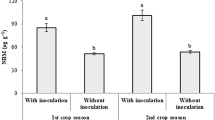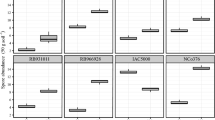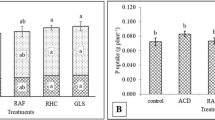Abstract
To explore the effects of mixed cropping of different sugarcane varieties on the growth of sugarcane and the community structure of arbuscular mycorrhizal fungi (AMF), field experiments were conducted using ROC22 and GT29 sugarcane varieties as test materials, with monoculture and mixed cropping treatments. The results showed that mixed cropping of sugarcane varieties did not increase the cane yield but improved the brix in GT29. Regardless of monoculture or mixed cropping, the dominant genera of AMF in the rhizosphere soil of ROC22 and GT29 were Glomus and Acaulospora, but mixed cropping decreased the relative abundance of Glomus and increased the relative abundance of Acaulospora. The mixed cropping treatment had no significant effect on the diversity of AMF and their colonization in the rhizosphere of sugarcane. Soil available phosphorus content was the main environmental factor affecting the colonization and community composition of AMF in the rhizosphere of sugarcane. Mixed cropping of different sugarcane varieties can improve sugarcane growth and enhance the community structure of AMF in the rhizosphere.






Similar content being viewed by others
References
Bao, S.D. 2000. Soil and agricultural chemistry analysis, 3rd ed. Beijing: China Agricultural Press.
Bigott, A.F., J.W. Hoy, and L.M. Fultz. 2019. Soil properties, microbial communities, and sugarcane yield in paired fields with short-or long-term sugarcane cultivation histories. Applied Soil Ecology 142: 166–176.
Brundrett, M.C., and L. Tedersoo. 2018. Evolutionary history of mycorrhizal symbioses and global host plant diversity. New Phytologists 220: 1108–1115.
Chen, T.S., S. Li, J.L. Zhang, X.J. Qin, H.J. Liu, Y.M. Tan, Z.N. Yuan, and Y.R. Li. 2011. Research on the formation of arbuscular mycorrhizae in sugarcane. Southwest China Journal of Agricultural Sciences 24 (5): 1757–1760.
Chen, T.S., J.L. Zhang, S. Li, X.J. Qin, Q. Wang, C.Q. Wang, S.J. Wu, Y.M. Tan, R.Z. Yang, and Y.R. Li. 2012. Diversity of arbuscular mycorrhizal fungi in sugarcane fields of Southeastern Guangxi. Journal of Southern Agriculture 43 (1): 57–61.
Chen, T.S., J.L. Zhang, and Y.Y. Long. 2015. Morphological spectrum of AM fungi in rhizosphere of sugarcane in Guangxi. Nanning: Guangxi Science and Technology Press.
Delavaux, C.S., L.M. Smith-Ramesh, and S.E. Kuebbing. 2017. Beyond nutrients: A meta-analysis of the diverse effects of arbuscular mycorrhizal fungi on plants and soils. Ecology 98: 2111–2119.
Edwards, J., C. Johnson, C. Santos-Medellın, E. Lurie, N.K. Podishetty, S. Bhatnagar, J.A. Eisen, and V. Sundaresan. 2015. Structure, variation, and assembly of the root-associated microbiomes of rice. Proceedings of the National Academy of Sciences of the United States of America 112: E911–E920.
Genre, A., L. Lanfranco, S. Perotto, and P. Bonfante. 2020. Unique and common traits in mycorrhizal symbioses. Nature Reviews Microbiology 18: 649–660.
Gentile, A., T.H. Ferreira, R.S. Mattos, L.I. Dias, A.A. Hoshino, M.S. Carneiro, G.M. Souza, T. Calsa, R.M. Nogueira, L. Endres, and M. Menossi. 2013. Effects of drought on the microtranscriptome of field-grown sugarcane plants. Planta 237: 783–798.
Hase, C., N. Ghayal, P. Taware, and K. Dhumal. 2011. Influence of sugarcane monocropping on rhizosphere microflora, soil enzymes and NPK status. International Journal of Pharma and Bio Sciences 2: 188–202.
Hiiesalu, I., M. Pärtel, J. Davison, P. Gerhold, M. Metsis, M. Moora, M. Öpik, M. Vasar, M. Zobel, and S.D. Wilson. 2014. Species richness of arbuscular mycorrhizal fungi: Associations with grassland plant richness and biomass. New Phytologists 203 (1): 233–244.
Hu, X., S.J. Gao, and Z.M. Jiang. 2022. Effect of variety mixed cropping on soybean cyst nematode disease. Modern Agriculture 8: 8–11.
Khalil, F., N.Y. Xiao, M. Tayyab, and P.H. Chen. 2018. Screening of EMS-induced drought-tolerant sugarcane mutants employing physiological, molecular and enzymatic approaches. Agronomy 8: 1–13.
Kiers, E.T., M. Duhamel, Y. Beesetty, J.A. Mensah, O. Franken, E. Verbruggen, C.R. Fellbaum, G.A. Kowalchuk, M.M. Hart, A. Bago, T.M. Palmer, S.A. West, P. Vandenkoornhuyse, J. Jansa, and H. Bücking. 2011. Reciprocal rewards stabilize cooperation in the mycorrhizal symbiosis. Science 333: 880–882.
Lang, J.Q., S.X. Zhao, D. Wang, J.J. Li, H.L. Li, N. Zhou, J.J. Zhao, and Y.N. Li. 2022. Effects of arbuscular mycorrhizal fungi on heavy metals in rhizosphere soil, fibrous roots and rhizomes of Paris polyphylla var. yunnanensis. Natural Product Research and Development 34 (8): 1374–1384.
Lao, Y.Y., L.Q. Yin, and Y.Y. Zhang. 2022. Study on the digital development of sugarcane production in Guangxi. Guangxi Sugar Industry 42 (6): 35–38.
Li, S.F., and W.F. Rao. 2001. The effects of mixed cropping on the main agronomic traits and yield of oilseed rape. Tillage and Cultivation 2: 18–24.
Li, H.M., R. Wang, C.Z. Shi, W.M. Shi, and Y.L. Li. 2021. Effects of mixed cropping of different pepper varieties on yield and rhizosphere nitrogen transformation. Soils 53 (6): 1167–1173.
Liao, N., J.L. Zhang, D.P. Li, Q. Wang, Y.Y. Long, Y.M. Tan, S. Li, Z.J. Lu, and T.S. Chen. 2016. Method to stain endophytic fungi in sugarcane roots. Southwest China Journal of Agricultural Sciences 29 (4): 814–819.
Lin, W., L. Wu, S. Lin, A. Zhang, M. Zhou, R. Lin, H. Wang, J. Chen, Z. Zhang, and R. Lin. 2013. Metaproteomic analysis of ratoon sugarcane rhizospheric soil. BMC Microbiology 13: 135.
Liu, L.Y. 2021. Effects of mixed cropping different varieties on agronomic traits, yield, and quality of maize. Agricultural Science and Technology Communication 8: 143–146.
Nasim, G., A. Ali, A. Munawar, and R. Bajwa. 2008. Seasonal dynamics of AM fungi in sugarcane (Saccharum officinarum L. Cv. SPF-213) in relation to red rot (Colletotrichum falcatum) disease from Punjab, Pakistan. Pakistan Journal of Botany 40: 2587–2600.
Pang, Q.J. 2015. Analysis of high-yield planting techniques and promotion benefits of ROC22. Agricultural Technology Service 32 (5): 29–30.
Peng, Z.L., Y.F. Zhong, C.M. Che, J.Z. Dong, L. Zhang, and Z. Dai. 2022. Effects of mixed cropping rice varieties in different proportions on rice quality. Sichuan Agricultural Science and Technology 1: 13–15.
Powell, J.R., and M.C. Rillig. 2018. Biodiversity of arbuscular mycorrhizal fungi and ecosystem function. New Phytologists 220: 1059–1075.
Raven, J.A., H. Lambers, S.E. Smith, and M. Westoby. 2018. Costs of acquiring phosphorus by vascular land plants: Patterns and implications for plant coexistence. New Phytologists 217: 1420–1427.
Reis, V.M., M.A. de Paula, and J. Döbereiner. 1999. Occurrence of arbuscular mycorrhizae and bacterium Acetobacter diazotrophicus in sugarcane. Pesquisa Agropecuaria Brasileira 34: 1933–1941.
Rokni, N., M.E. Goltapeh, and A. Alizadeh. 2010. Some new recorded species of arbuscular mycorrhizal fungi associated with sugarcane crop in Iran. Agric Technol 6: 67–78.
Schröder, R., M. Mohri, and K. Kiehl. 2019. AMF inoculation of green roof substrate improves plant performance but reduces drought resistance of native dry grassland species. Ecological Engineering 139: 105583.
Sivakumar, N. 2013. Effect of edaphic factors and seasonal variation on spore density and root colonization of arbuscular mycorrhizal fungi in sugarcane fields. Annual Review of Microbiology 63: 151–160.
Smith, S.E., and D.J. Read. 2008. Mycorrhizal symbiosis, 3rd ed. San Diego: Academic Press.
Smith, S.E., and D.J. Read. 2010. Mycorrhizal symbiosis, 3rd ed. London: Academic Press.
Smith, S.E., and F.A. Smith. 2011. Roles of arbuscular mycorrhizas in plant nutrition and growth: New paradigms from cellular to ecosystem scales. Annual Review of Plant Biology 62: 227–250.
Song, Y.C., X.L. Li, G. Feng, F.S. Zhang, and C. Peter. 2000. Rapid assessment of acid phosphatase activity in the mycorrhizosphere and in arbuscular mycorrhizal fungal hyphae. Chinese Science Bulletin 45 (13): 1187–1191.
Song, H.Z., W.X. Duan, R.H. Zhang, and Z.P. Wang. 2013. Guangxi sugarcane variety GT-29 with strong ratoon and high-yield planting techniques. China Seeds S1: 60–61.
Sun, J.H., Y.L. Bi, L. Qiu, and B. Jiang. 2016. A Review about the effect of AMF on uptaking phosphorus by host plants in soil. Chinese Journal of Soil Science 47 (2): 499–504.
Tayyab, M., Z.Q. Yang, C.F. Zhang, W. Islam, W.X. Lin, and H. Zhang. 2021. Sugarcane monoculture drives microbial community composition, activity and abundance of agricultural-related microorganisms. Environmental Science and Pollution Research 28 (35): 48080–48096.
Turrini, A., A. Bedini, M.B. Loor, G. Santini, C. Sbrana, M. Giovannetti, and L. Avio. 2018. Local diversity of native arbuscular mycorrhizal symbionts differentially affects growth and nutrition of three crop plant species. Biology and Fertility of Soils 54 (2): 203–217.
Van Der Heijden, M.G.A., T. Boller, A. Wiemken, and I.R. Sanders. 1998. Different arbuscular mycorrhizal fungi species are potential determinants of plant community structure. Ecology 79: 2082–2091.
Wang, H.L., Q. Jiang, S.Q. Cao, Z.Y. Sun, and H.G. Wang. 2022. Effects of variety mixed cropping on stripe rust occurrence and wheat yield. Journal of China Agricultural University 27 (4): 1–21.
Wilson, G.W.T., C.W. Rice, M.C. Rillig, A. Springer, and D.C. Hartnett. 2009. Soil aggregation and carbon sequestration are tightly correlated with the abundance of arbuscular mycorrhizal fungi: Results from long-term field experiments. Ecology Letters 12: 452–461.
Wipf, D., F. Krajinski, D. Tuinen, G. Recorbet, and P.E. Courty. 2019. Trading on the arbuscular mycorrhiza market: From arbuscules to common mycorrhizal networks. New Phytologists 223: 1127–1142.
Wu, R.D., C.L. Tan, T.H. Li, C.H. Lei, J.F. Wei, F.L. Yu, Q. Wang, Y.M. Tan, and T.S. Chen. 2015. Influence of inoculation of arbuscular mycorrhizal fungi on sugarcane variety Fu-Nong 41 grown in field. Sugarcane and Canesugar 4: 20.
Wyatt, G.A.K., E.T. Kiers, A. Gardner, and S.A. West. 2014. A biological market analysis of the plant-mycorrhizal symbiosis. Evolution 68 (9): 2603–2618.
Xu, P., L.Z. Liang, X.Y. Dong, J. Xu, P.K. Jiang, and R.F. Shen. 2014. Response of soil phosphorus required for maximum growth of Asparagus officinalis L. to inoculation of arbuscular mycorrhizal fungi. Pedosphere 24 (6): 776–782.
Yang, H.S., Y.Q. Xiong, Q. Wang, Y. Guo, Y.J. Dai, and M.M. Xu. 2016. Arbuscular mycorrhizal fungal species diversity: Ecological functioning, determinants and assembling mechanisms. Acta Ecologica Sinica 36 (10): 2826–2832.
Zhang, J.X., L. Su, M. Jiang, M.R. Li, C. Wang, Y.M. He, J.J. Chen, and F.D. Zhan. 2022. Effects of arbuscular mycorrhizal fungi on Cd leaching loss in contaminated soil and its preliminary mechanism. Journal of Agro-Environment Science 41 (9): 1936–1943.
Acknowledgements
This work was supported by Guangxi Natural Science Fund key project (2019GXNSFDA245013), Guangxi Science and Technology Base and Talents Special Project (AD20159001), Guangxi Key R&D Program project (GK-AA22117009), Guangxi Academy of Agricultural Sciences project (2023YM96, GNK2021009), and Project of Guangxi Sugarcane Innovation team of National Modern Agriculture Industry Technology System (gjnytxgxcxtd-2021-03-01). The Authors thank Dr. Shangjiao Jiang of Nanjing Agricultural University for providing guidance on the data analyses and appreciate the help of Dr. Haiying Liang of Department of Genetic and Biochemistry, Clemson University, in editing the manuscript.
Author information
Authors and Affiliations
Corresponding authors
Ethics declarations
Conflict of interest
The authors declare that they have no conflict of interest.
Additional information
Publisher's Note
Springer Nature remains neutral with regard to jurisdictional claims in published maps and institutional affiliations.
Rights and permissions
Springer Nature or its licensor (e.g. a society or other partner) holds exclusive rights to this article under a publishing agreement with the author(s) or other rightsholder(s); author self-archiving of the accepted manuscript version of this article is solely governed by the terms of such publishing agreement and applicable law.
About this article
Cite this article
Nong, YJ., Wang, Q., Song, J. et al. Effects of Mixed Cropping on Sugarcane Growth and the Community of Arbuscular Mycorrhizal Fungi. Sugar Tech 25, 1456–1466 (2023). https://doi.org/10.1007/s12355-023-01303-x
Received:
Accepted:
Published:
Issue Date:
DOI: https://doi.org/10.1007/s12355-023-01303-x




